Commercial Law: Analysis of Contractual Agreements Case Study
VerifiedAdded on 2020/04/21
|10
|1903
|117
Case Study
AI Summary
This case study delves into a commercial law scenario involving Alan and his potential contractual agreements with Charleen, Damien, and Bernard. The analysis examines the essential elements of a valid contract, including offer, acceptance, and intention to create legal relations. It assesses the validity of agreements with each individual, considering factors like capacity, counter-offers, and communication. The study also explores the legal positions of Charleen (a minor), Bernard, and Damien, providing solutions for each. Furthermore, it discusses alternative dispute resolution (ADR) methods like arbitration and mediation, highlighting their advantages and disadvantages. The case concludes by identifying breaches of contract and determining appropriate remedies for the affected parties, providing a comprehensive understanding of contractual law principles.
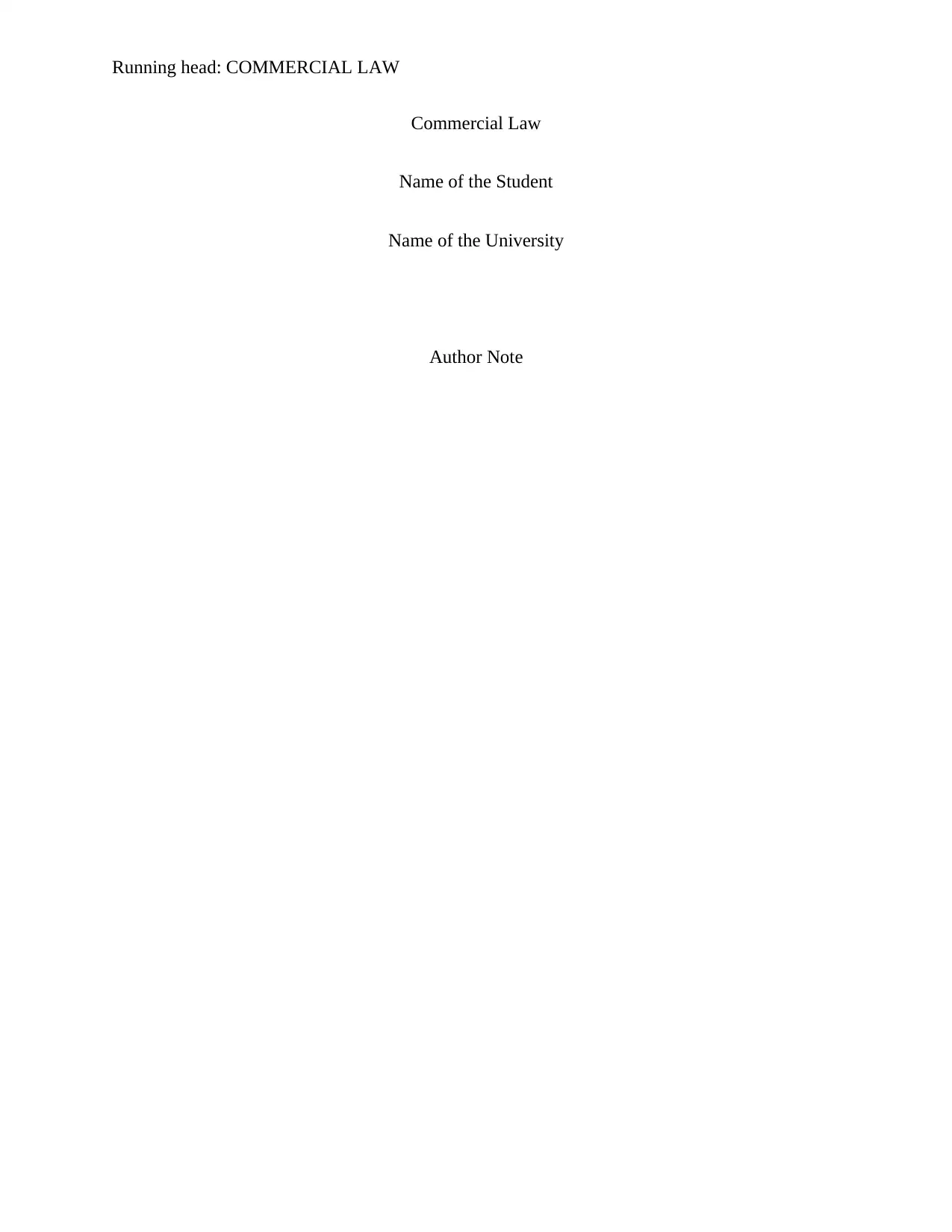
Running head: COMMERCIAL LAW
Commercial Law
Name of the Student
Name of the University
Author Note
Commercial Law
Name of the Student
Name of the University
Author Note
Paraphrase This Document
Need a fresh take? Get an instant paraphrase of this document with our AI Paraphraser
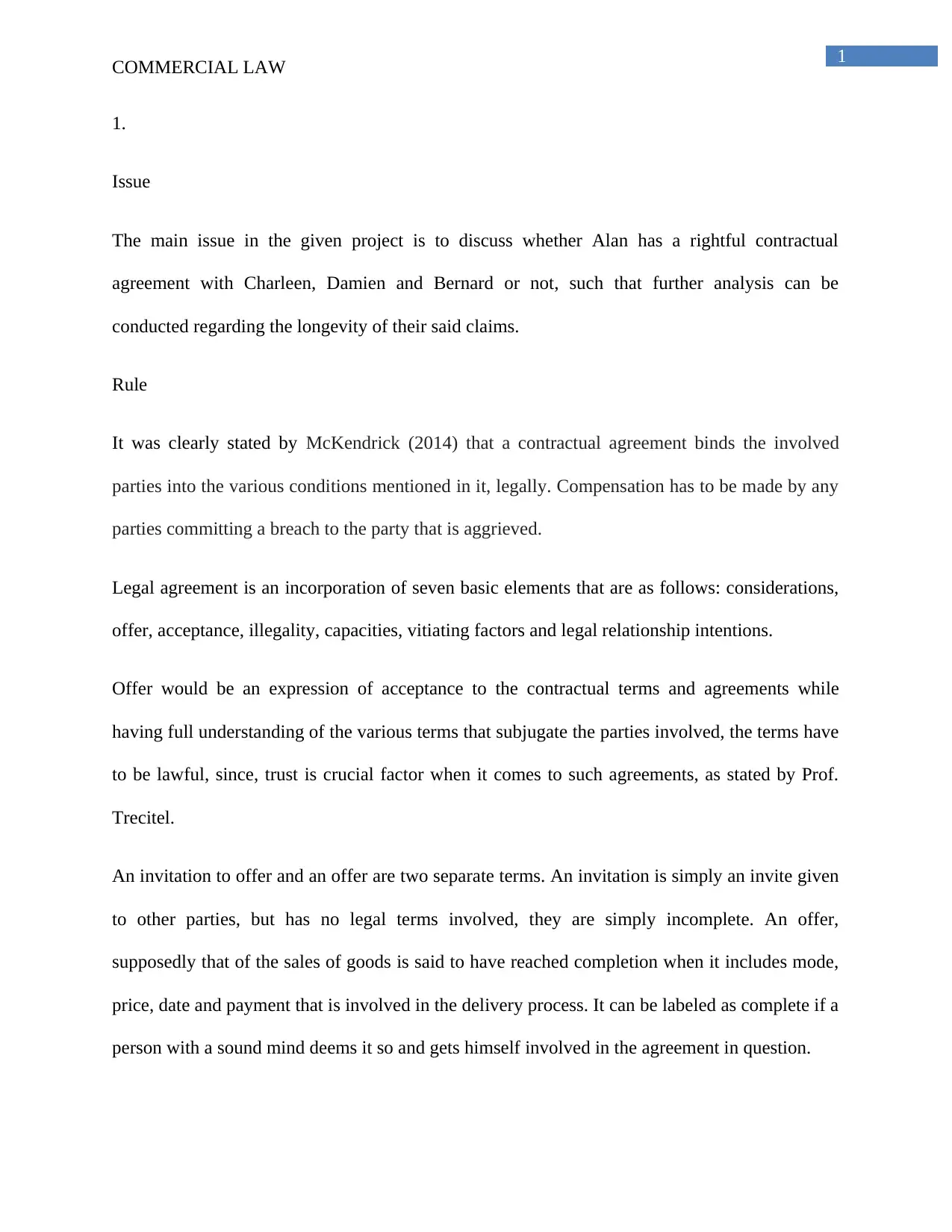
1
COMMERCIAL LAW
1.
Issue
The main issue in the given project is to discuss whether Alan has a rightful contractual
agreement with Charleen, Damien and Bernard or not, such that further analysis can be
conducted regarding the longevity of their said claims.
Rule
It was clearly stated by McKendrick (2014) that a contractual agreement binds the involved
parties into the various conditions mentioned in it, legally. Compensation has to be made by any
parties committing a breach to the party that is aggrieved.
Legal agreement is an incorporation of seven basic elements that are as follows: considerations,
offer, acceptance, illegality, capacities, vitiating factors and legal relationship intentions.
Offer would be an expression of acceptance to the contractual terms and agreements while
having full understanding of the various terms that subjugate the parties involved, the terms have
to be lawful, since, trust is crucial factor when it comes to such agreements, as stated by Prof.
Trecitel.
An invitation to offer and an offer are two separate terms. An invitation is simply an invite given
to other parties, but has no legal terms involved, they are simply incomplete. An offer,
supposedly that of the sales of goods is said to have reached completion when it includes mode,
price, date and payment that is involved in the delivery process. It can be labeled as complete if a
person with a sound mind deems it so and gets himself involved in the agreement in question.
COMMERCIAL LAW
1.
Issue
The main issue in the given project is to discuss whether Alan has a rightful contractual
agreement with Charleen, Damien and Bernard or not, such that further analysis can be
conducted regarding the longevity of their said claims.
Rule
It was clearly stated by McKendrick (2014) that a contractual agreement binds the involved
parties into the various conditions mentioned in it, legally. Compensation has to be made by any
parties committing a breach to the party that is aggrieved.
Legal agreement is an incorporation of seven basic elements that are as follows: considerations,
offer, acceptance, illegality, capacities, vitiating factors and legal relationship intentions.
Offer would be an expression of acceptance to the contractual terms and agreements while
having full understanding of the various terms that subjugate the parties involved, the terms have
to be lawful, since, trust is crucial factor when it comes to such agreements, as stated by Prof.
Trecitel.
An invitation to offer and an offer are two separate terms. An invitation is simply an invite given
to other parties, but has no legal terms involved, they are simply incomplete. An offer,
supposedly that of the sales of goods is said to have reached completion when it includes mode,
price, date and payment that is involved in the delivery process. It can be labeled as complete if a
person with a sound mind deems it so and gets himself involved in the agreement in question.
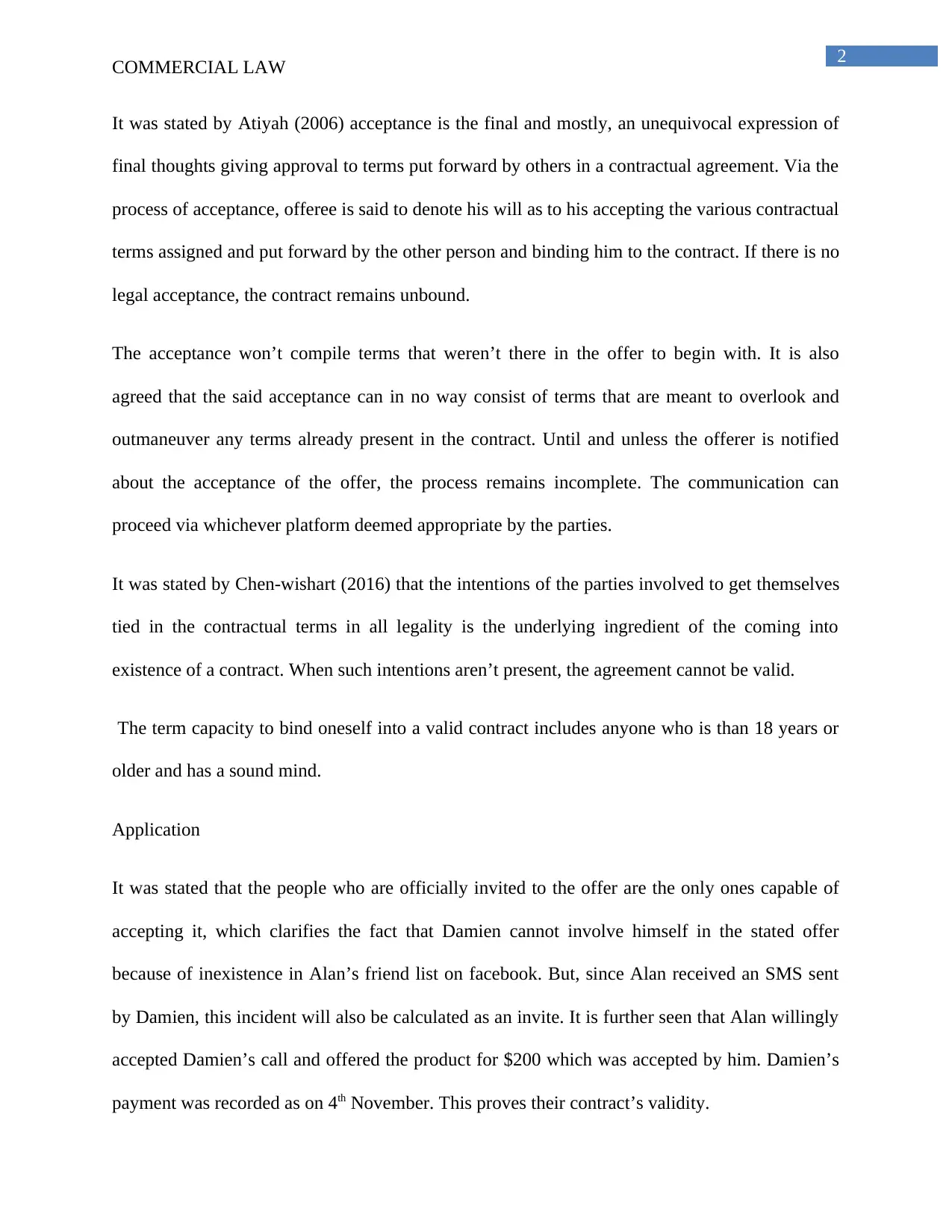
2
COMMERCIAL LAW
It was stated by Atiyah (2006) acceptance is the final and mostly, an unequivocal expression of
final thoughts giving approval to terms put forward by others in a contractual agreement. Via the
process of acceptance, offeree is said to denote his will as to his accepting the various contractual
terms assigned and put forward by the other person and binding him to the contract. If there is no
legal acceptance, the contract remains unbound.
The acceptance won’t compile terms that weren’t there in the offer to begin with. It is also
agreed that the said acceptance can in no way consist of terms that are meant to overlook and
outmaneuver any terms already present in the contract. Until and unless the offerer is notified
about the acceptance of the offer, the process remains incomplete. The communication can
proceed via whichever platform deemed appropriate by the parties.
It was stated by Chen-wishart (2016) that the intentions of the parties involved to get themselves
tied in the contractual terms in all legality is the underlying ingredient of the coming into
existence of a contract. When such intentions aren’t present, the agreement cannot be valid.
The term capacity to bind oneself into a valid contract includes anyone who is than 18 years or
older and has a sound mind.
Application
It was stated that the people who are officially invited to the offer are the only ones capable of
accepting it, which clarifies the fact that Damien cannot involve himself in the stated offer
because of inexistence in Alan’s friend list on facebook. But, since Alan received an SMS sent
by Damien, this incident will also be calculated as an invite. It is further seen that Alan willingly
accepted Damien’s call and offered the product for $200 which was accepted by him. Damien’s
payment was recorded as on 4th November. This proves their contract’s validity.
COMMERCIAL LAW
It was stated by Atiyah (2006) acceptance is the final and mostly, an unequivocal expression of
final thoughts giving approval to terms put forward by others in a contractual agreement. Via the
process of acceptance, offeree is said to denote his will as to his accepting the various contractual
terms assigned and put forward by the other person and binding him to the contract. If there is no
legal acceptance, the contract remains unbound.
The acceptance won’t compile terms that weren’t there in the offer to begin with. It is also
agreed that the said acceptance can in no way consist of terms that are meant to overlook and
outmaneuver any terms already present in the contract. Until and unless the offerer is notified
about the acceptance of the offer, the process remains incomplete. The communication can
proceed via whichever platform deemed appropriate by the parties.
It was stated by Chen-wishart (2016) that the intentions of the parties involved to get themselves
tied in the contractual terms in all legality is the underlying ingredient of the coming into
existence of a contract. When such intentions aren’t present, the agreement cannot be valid.
The term capacity to bind oneself into a valid contract includes anyone who is than 18 years or
older and has a sound mind.
Application
It was stated that the people who are officially invited to the offer are the only ones capable of
accepting it, which clarifies the fact that Damien cannot involve himself in the stated offer
because of inexistence in Alan’s friend list on facebook. But, since Alan received an SMS sent
by Damien, this incident will also be calculated as an invite. It is further seen that Alan willingly
accepted Damien’s call and offered the product for $200 which was accepted by him. Damien’s
payment was recorded as on 4th November. This proves their contract’s validity.
⊘ This is a preview!⊘
Do you want full access?
Subscribe today to unlock all pages.

Trusted by 1+ million students worldwide
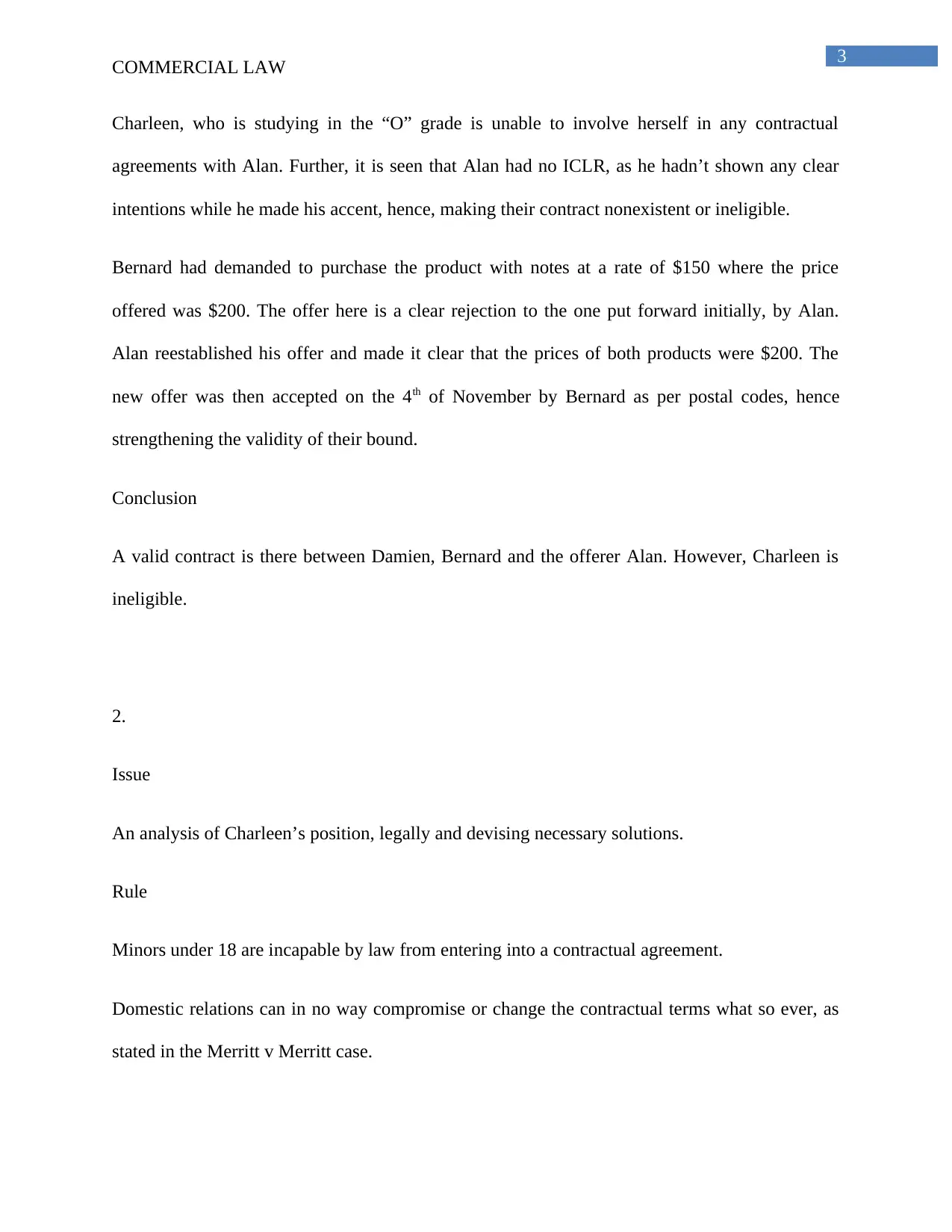
3
COMMERCIAL LAW
Charleen, who is studying in the “O” grade is unable to involve herself in any contractual
agreements with Alan. Further, it is seen that Alan had no ICLR, as he hadn’t shown any clear
intentions while he made his accent, hence, making their contract nonexistent or ineligible.
Bernard had demanded to purchase the product with notes at a rate of $150 where the price
offered was $200. The offer here is a clear rejection to the one put forward initially, by Alan.
Alan reestablished his offer and made it clear that the prices of both products were $200. The
new offer was then accepted on the 4th of November by Bernard as per postal codes, hence
strengthening the validity of their bound.
Conclusion
A valid contract is there between Damien, Bernard and the offerer Alan. However, Charleen is
ineligible.
2.
Issue
An analysis of Charleen’s position, legally and devising necessary solutions.
Rule
Minors under 18 are incapable by law from entering into a contractual agreement.
Domestic relations can in no way compromise or change the contractual terms what so ever, as
stated in the Merritt v Merritt case.
COMMERCIAL LAW
Charleen, who is studying in the “O” grade is unable to involve herself in any contractual
agreements with Alan. Further, it is seen that Alan had no ICLR, as he hadn’t shown any clear
intentions while he made his accent, hence, making their contract nonexistent or ineligible.
Bernard had demanded to purchase the product with notes at a rate of $150 where the price
offered was $200. The offer here is a clear rejection to the one put forward initially, by Alan.
Alan reestablished his offer and made it clear that the prices of both products were $200. The
new offer was then accepted on the 4th of November by Bernard as per postal codes, hence
strengthening the validity of their bound.
Conclusion
A valid contract is there between Damien, Bernard and the offerer Alan. However, Charleen is
ineligible.
2.
Issue
An analysis of Charleen’s position, legally and devising necessary solutions.
Rule
Minors under 18 are incapable by law from entering into a contractual agreement.
Domestic relations can in no way compromise or change the contractual terms what so ever, as
stated in the Merritt v Merritt case.
Paraphrase This Document
Need a fresh take? Get an instant paraphrase of this document with our AI Paraphraser
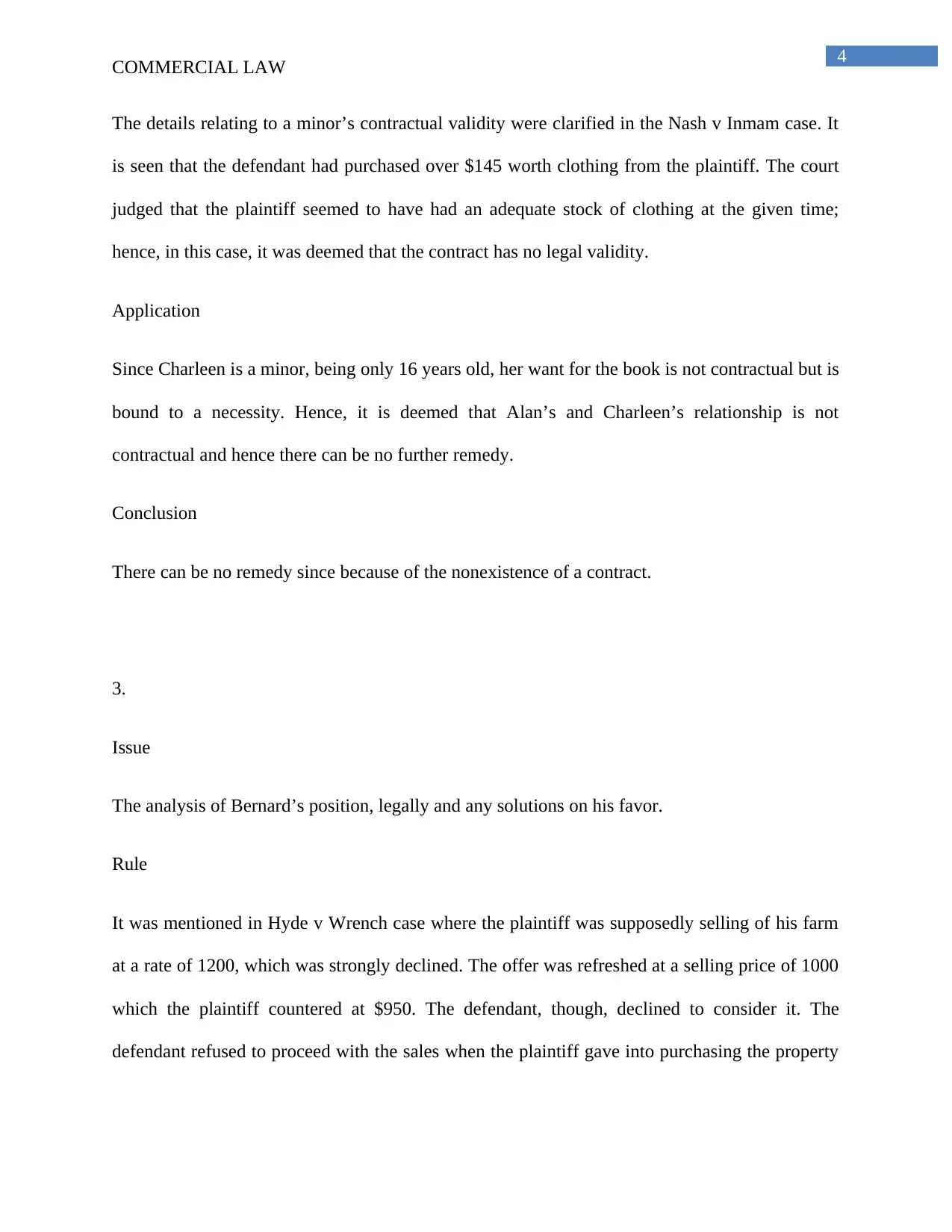
4
COMMERCIAL LAW
The details relating to a minor’s contractual validity were clarified in the Nash v Inmam case. It
is seen that the defendant had purchased over $145 worth clothing from the plaintiff. The court
judged that the plaintiff seemed to have had an adequate stock of clothing at the given time;
hence, in this case, it was deemed that the contract has no legal validity.
Application
Since Charleen is a minor, being only 16 years old, her want for the book is not contractual but is
bound to a necessity. Hence, it is deemed that Alan’s and Charleen’s relationship is not
contractual and hence there can be no further remedy.
Conclusion
There can be no remedy since because of the nonexistence of a contract.
3.
Issue
The analysis of Bernard’s position, legally and any solutions on his favor.
Rule
It was mentioned in Hyde v Wrench case where the plaintiff was supposedly selling of his farm
at a rate of 1200, which was strongly declined. The offer was refreshed at a selling price of 1000
which the plaintiff countered at $950. The defendant, though, declined to consider it. The
defendant refused to proceed with the sales when the plaintiff gave into purchasing the property
COMMERCIAL LAW
The details relating to a minor’s contractual validity were clarified in the Nash v Inmam case. It
is seen that the defendant had purchased over $145 worth clothing from the plaintiff. The court
judged that the plaintiff seemed to have had an adequate stock of clothing at the given time;
hence, in this case, it was deemed that the contract has no legal validity.
Application
Since Charleen is a minor, being only 16 years old, her want for the book is not contractual but is
bound to a necessity. Hence, it is deemed that Alan’s and Charleen’s relationship is not
contractual and hence there can be no further remedy.
Conclusion
There can be no remedy since because of the nonexistence of a contract.
3.
Issue
The analysis of Bernard’s position, legally and any solutions on his favor.
Rule
It was mentioned in Hyde v Wrench case where the plaintiff was supposedly selling of his farm
at a rate of 1200, which was strongly declined. The offer was refreshed at a selling price of 1000
which the plaintiff countered at $950. The defendant, though, declined to consider it. The
defendant refused to proceed with the sales when the plaintiff gave into purchasing the property
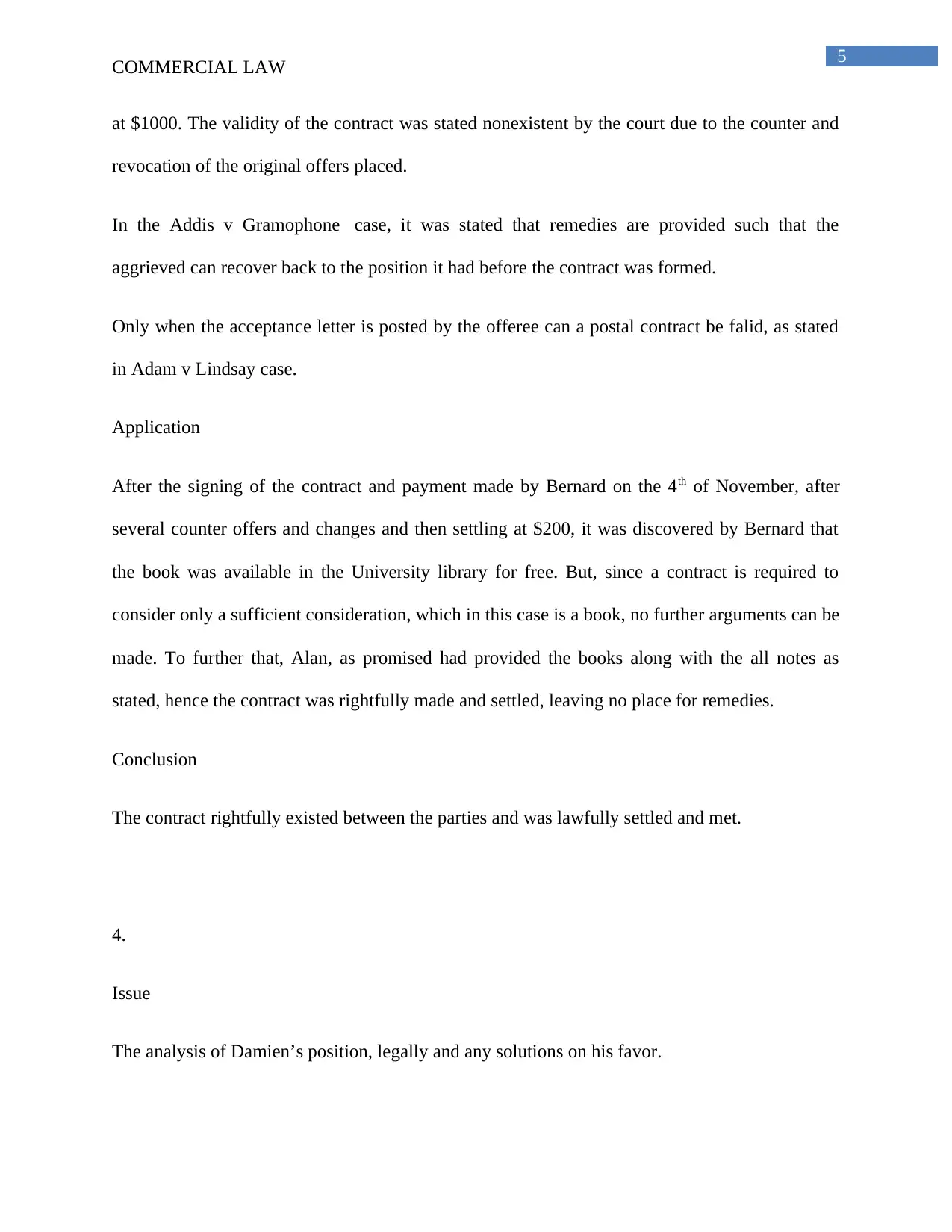
5
COMMERCIAL LAW
at $1000. The validity of the contract was stated nonexistent by the court due to the counter and
revocation of the original offers placed.
In the Addis v Gramophone case, it was stated that remedies are provided such that the
aggrieved can recover back to the position it had before the contract was formed.
Only when the acceptance letter is posted by the offeree can a postal contract be falid, as stated
in Adam v Lindsay case.
Application
After the signing of the contract and payment made by Bernard on the 4th of November, after
several counter offers and changes and then settling at $200, it was discovered by Bernard that
the book was available in the University library for free. But, since a contract is required to
consider only a sufficient consideration, which in this case is a book, no further arguments can be
made. To further that, Alan, as promised had provided the books along with the all notes as
stated, hence the contract was rightfully made and settled, leaving no place for remedies.
Conclusion
The contract rightfully existed between the parties and was lawfully settled and met.
4.
Issue
The analysis of Damien’s position, legally and any solutions on his favor.
COMMERCIAL LAW
at $1000. The validity of the contract was stated nonexistent by the court due to the counter and
revocation of the original offers placed.
In the Addis v Gramophone case, it was stated that remedies are provided such that the
aggrieved can recover back to the position it had before the contract was formed.
Only when the acceptance letter is posted by the offeree can a postal contract be falid, as stated
in Adam v Lindsay case.
Application
After the signing of the contract and payment made by Bernard on the 4th of November, after
several counter offers and changes and then settling at $200, it was discovered by Bernard that
the book was available in the University library for free. But, since a contract is required to
consider only a sufficient consideration, which in this case is a book, no further arguments can be
made. To further that, Alan, as promised had provided the books along with the all notes as
stated, hence the contract was rightfully made and settled, leaving no place for remedies.
Conclusion
The contract rightfully existed between the parties and was lawfully settled and met.
4.
Issue
The analysis of Damien’s position, legally and any solutions on his favor.
⊘ This is a preview!⊘
Do you want full access?
Subscribe today to unlock all pages.

Trusted by 1+ million students worldwide
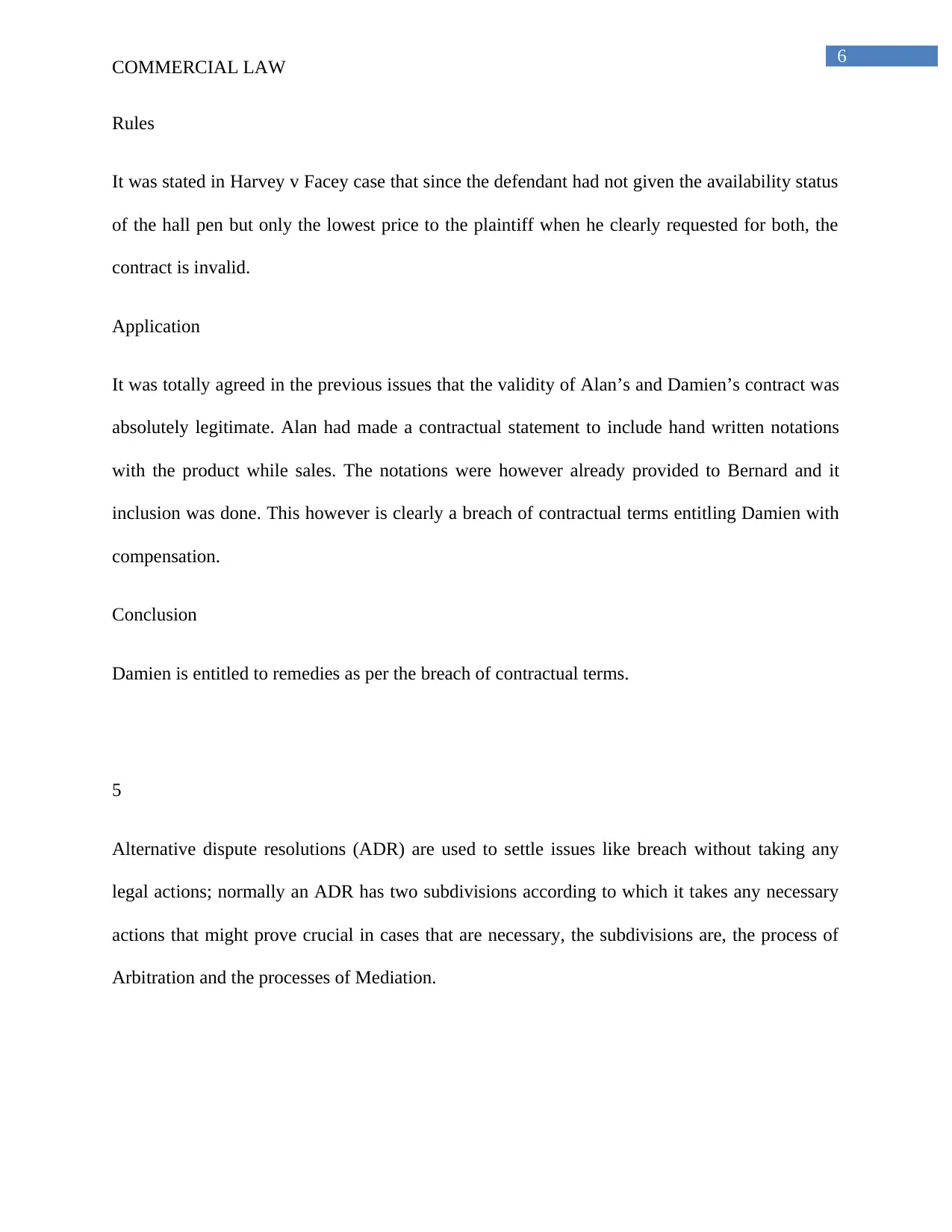
6
COMMERCIAL LAW
Rules
It was stated in Harvey v Facey case that since the defendant had not given the availability status
of the hall pen but only the lowest price to the plaintiff when he clearly requested for both, the
contract is invalid.
Application
It was totally agreed in the previous issues that the validity of Alan’s and Damien’s contract was
absolutely legitimate. Alan had made a contractual statement to include hand written notations
with the product while sales. The notations were however already provided to Bernard and it
inclusion was done. This however is clearly a breach of contractual terms entitling Damien with
compensation.
Conclusion
Damien is entitled to remedies as per the breach of contractual terms.
5
Alternative dispute resolutions (ADR) are used to settle issues like breach without taking any
legal actions; normally an ADR has two subdivisions according to which it takes any necessary
actions that might prove crucial in cases that are necessary, the subdivisions are, the process of
Arbitration and the processes of Mediation.
COMMERCIAL LAW
Rules
It was stated in Harvey v Facey case that since the defendant had not given the availability status
of the hall pen but only the lowest price to the plaintiff when he clearly requested for both, the
contract is invalid.
Application
It was totally agreed in the previous issues that the validity of Alan’s and Damien’s contract was
absolutely legitimate. Alan had made a contractual statement to include hand written notations
with the product while sales. The notations were however already provided to Bernard and it
inclusion was done. This however is clearly a breach of contractual terms entitling Damien with
compensation.
Conclusion
Damien is entitled to remedies as per the breach of contractual terms.
5
Alternative dispute resolutions (ADR) are used to settle issues like breach without taking any
legal actions; normally an ADR has two subdivisions according to which it takes any necessary
actions that might prove crucial in cases that are necessary, the subdivisions are, the process of
Arbitration and the processes of Mediation.
Paraphrase This Document
Need a fresh take? Get an instant paraphrase of this document with our AI Paraphraser
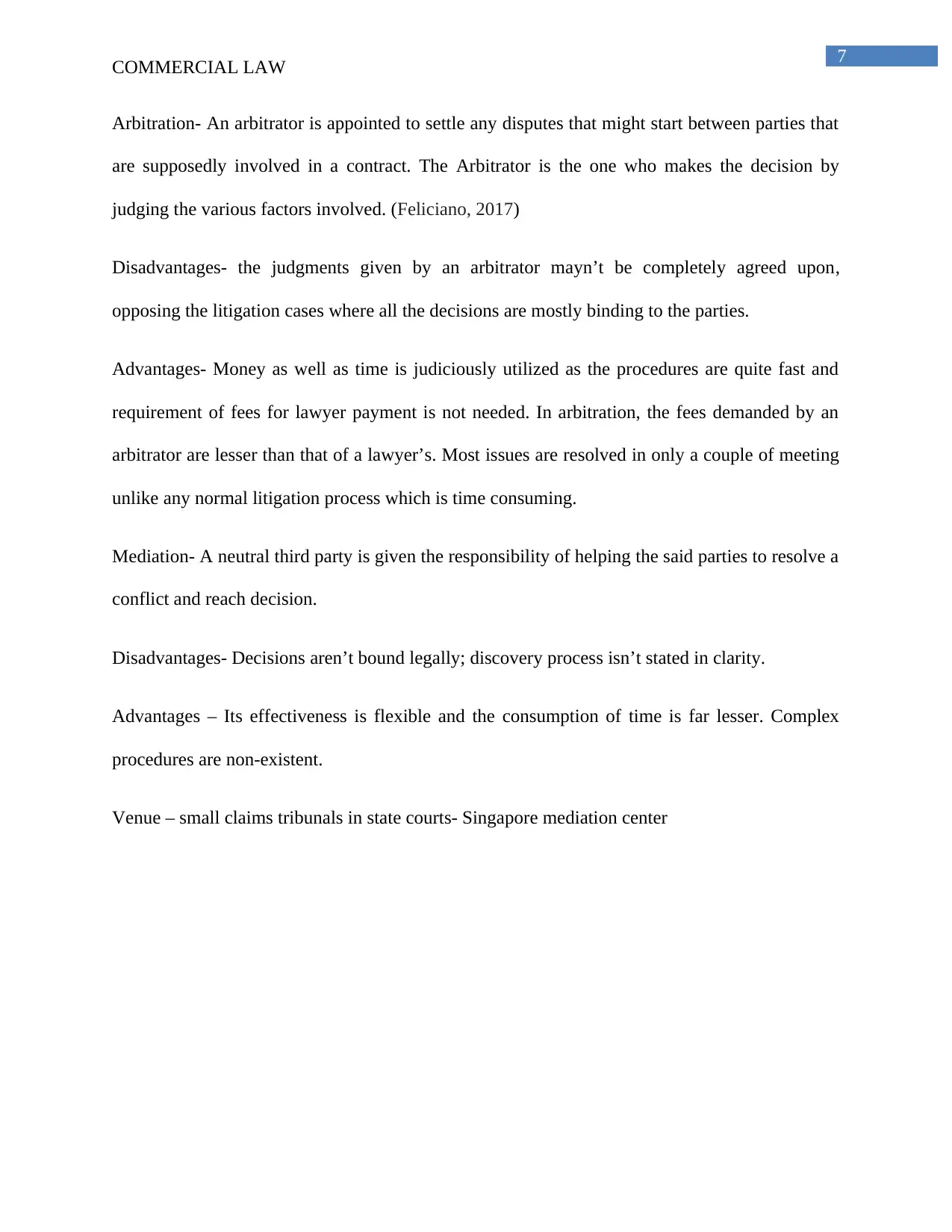
7
COMMERCIAL LAW
Arbitration- An arbitrator is appointed to settle any disputes that might start between parties that
are supposedly involved in a contract. The Arbitrator is the one who makes the decision by
judging the various factors involved. (Feliciano, 2017)
Disadvantages- the judgments given by an arbitrator mayn’t be completely agreed upon,
opposing the litigation cases where all the decisions are mostly binding to the parties.
Advantages- Money as well as time is judiciously utilized as the procedures are quite fast and
requirement of fees for lawyer payment is not needed. In arbitration, the fees demanded by an
arbitrator are lesser than that of a lawyer’s. Most issues are resolved in only a couple of meeting
unlike any normal litigation process which is time consuming.
Mediation- A neutral third party is given the responsibility of helping the said parties to resolve a
conflict and reach decision.
Disadvantages- Decisions aren’t bound legally; discovery process isn’t stated in clarity.
Advantages – Its effectiveness is flexible and the consumption of time is far lesser. Complex
procedures are non-existent.
Venue – small claims tribunals in state courts- Singapore mediation center
COMMERCIAL LAW
Arbitration- An arbitrator is appointed to settle any disputes that might start between parties that
are supposedly involved in a contract. The Arbitrator is the one who makes the decision by
judging the various factors involved. (Feliciano, 2017)
Disadvantages- the judgments given by an arbitrator mayn’t be completely agreed upon,
opposing the litigation cases where all the decisions are mostly binding to the parties.
Advantages- Money as well as time is judiciously utilized as the procedures are quite fast and
requirement of fees for lawyer payment is not needed. In arbitration, the fees demanded by an
arbitrator are lesser than that of a lawyer’s. Most issues are resolved in only a couple of meeting
unlike any normal litigation process which is time consuming.
Mediation- A neutral third party is given the responsibility of helping the said parties to resolve a
conflict and reach decision.
Disadvantages- Decisions aren’t bound legally; discovery process isn’t stated in clarity.
Advantages – Its effectiveness is flexible and the consumption of time is far lesser. Complex
procedures are non-existent.
Venue – small claims tribunals in state courts- Singapore mediation center
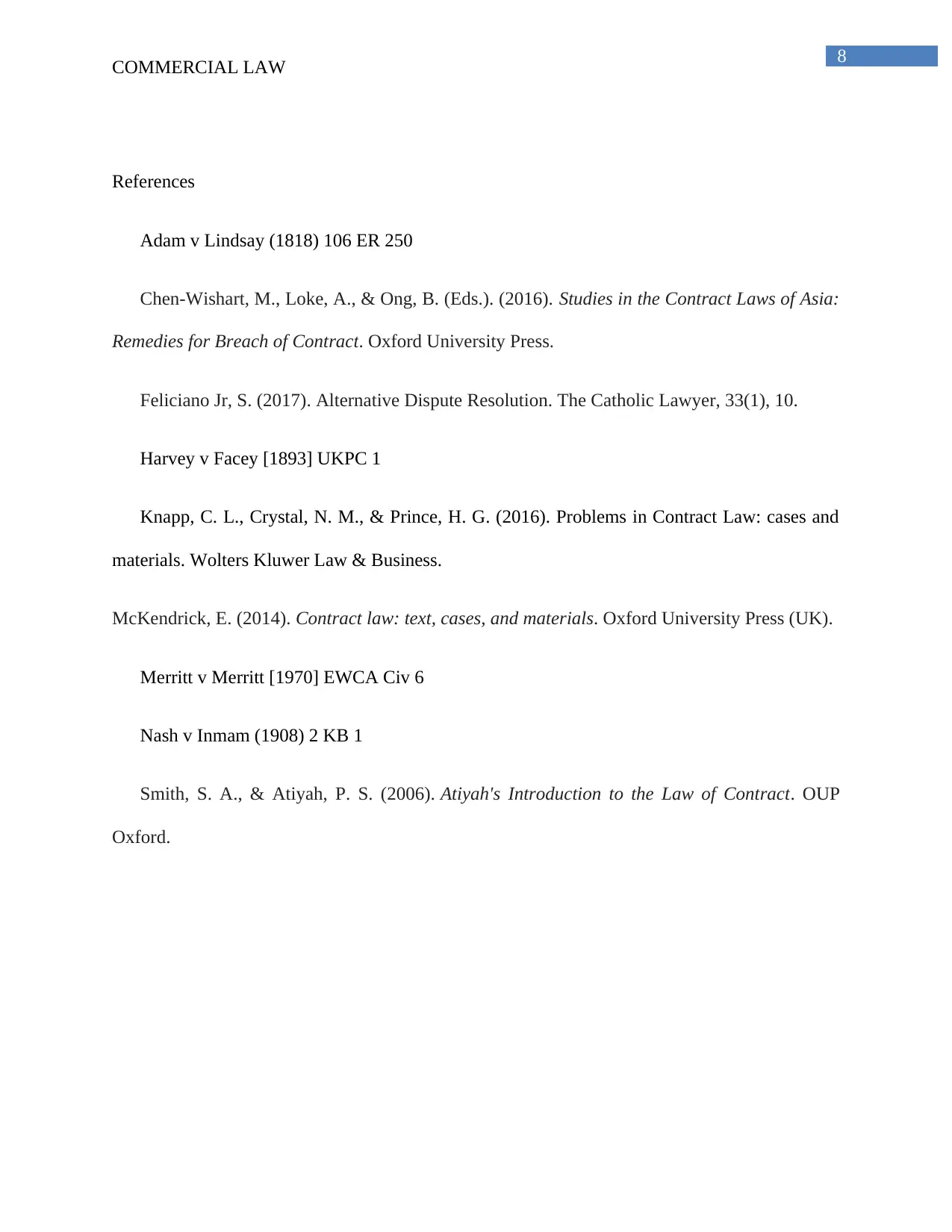
8
COMMERCIAL LAW
References
Adam v Lindsay (1818) 106 ER 250
Chen-Wishart, M., Loke, A., & Ong, B. (Eds.). (2016). Studies in the Contract Laws of Asia:
Remedies for Breach of Contract. Oxford University Press.
Feliciano Jr, S. (2017). Alternative Dispute Resolution. The Catholic Lawyer, 33(1), 10.
Harvey v Facey [1893] UKPC 1
Knapp, C. L., Crystal, N. M., & Prince, H. G. (2016). Problems in Contract Law: cases and
materials. Wolters Kluwer Law & Business.
McKendrick, E. (2014). Contract law: text, cases, and materials. Oxford University Press (UK).
Merritt v Merritt [1970] EWCA Civ 6
Nash v Inmam (1908) 2 KB 1
Smith, S. A., & Atiyah, P. S. (2006). Atiyah's Introduction to the Law of Contract. OUP
Oxford.
COMMERCIAL LAW
References
Adam v Lindsay (1818) 106 ER 250
Chen-Wishart, M., Loke, A., & Ong, B. (Eds.). (2016). Studies in the Contract Laws of Asia:
Remedies for Breach of Contract. Oxford University Press.
Feliciano Jr, S. (2017). Alternative Dispute Resolution. The Catholic Lawyer, 33(1), 10.
Harvey v Facey [1893] UKPC 1
Knapp, C. L., Crystal, N. M., & Prince, H. G. (2016). Problems in Contract Law: cases and
materials. Wolters Kluwer Law & Business.
McKendrick, E. (2014). Contract law: text, cases, and materials. Oxford University Press (UK).
Merritt v Merritt [1970] EWCA Civ 6
Nash v Inmam (1908) 2 KB 1
Smith, S. A., & Atiyah, P. S. (2006). Atiyah's Introduction to the Law of Contract. OUP
Oxford.
⊘ This is a preview!⊘
Do you want full access?
Subscribe today to unlock all pages.

Trusted by 1+ million students worldwide

9
COMMERCIAL LAW
COMMERCIAL LAW
1 out of 10
Related Documents
Your All-in-One AI-Powered Toolkit for Academic Success.
+13062052269
info@desklib.com
Available 24*7 on WhatsApp / Email
![[object Object]](/_next/static/media/star-bottom.7253800d.svg)
Unlock your academic potential
Copyright © 2020–2025 A2Z Services. All Rights Reserved. Developed and managed by ZUCOL.





